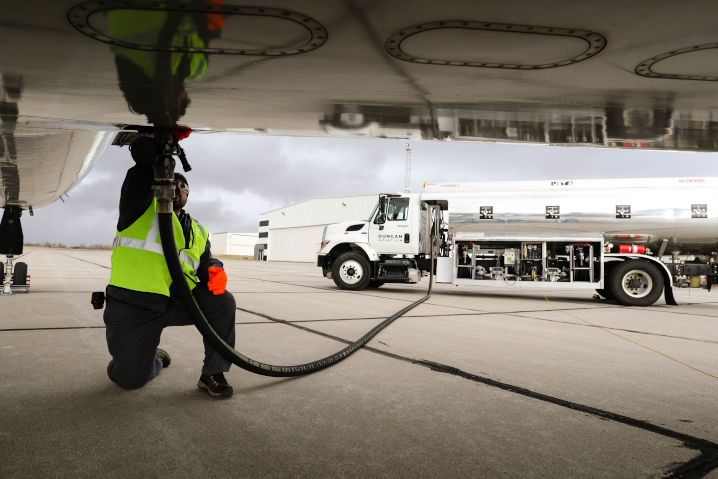
JET FUEL A-1,
Jet fuel, Aviation Turbine Fuel (ATF), or Avtur is a type of fuel designed for use in aircraft powered by gas-turbine engines. It is clear to straw-colored in appearance. The most commonly used fuels for commercial aviation are Jet A and Jet A-1 which are produced to a standardized international specification. The only other jet fuel commonly used in civilian turbine-engine powered aviation is Jet B which is used for its enhanced cold-weather performance. Aviation Fuel or Jet fuel is a mixture of a large number of different hydrocarbons. Kerosene-type jet fuel (including Jet A and Jet A-1) has a carbon number distribution between about 8 and 16 carbon numbers (carbon atoms per molecule); wide-cut or naphtha-type jet fuel (including Jet B), between about 5 and 15 carbon numbers. Aviation fuel or Jet Fuel is a specialized type of petroleum-based fuel used to power aircraft; it is generally of a higher quality than fuels used in less critical applications such as heating or road transport, and often contains additives to reduce the risk of icing or explosion due to high temperatures, amongst other properties.
AMERICAN CIVIL JET FUELS
The basic civil jet fuel specification used in the United States of America is ASTM Specification for Aviation Turbine Fuels D 1655, which defines the requirements for three grades of fuel:
Jet A, a kerosene type fuel having a maximum freeze point of -40 degrees C.
Jet A-1, a kerosene type fuel, identical with Jet A but with a maximum freeze point of -47 degrees C.
Jet B, a wide-cut type fuel.
Jet A is used within the United States by domestic and international airlines. Jet B is rarely available nowadays except in parts of northern Canada where its lower freeze point and higher volatility is an advantage for handling and cold starting.
CHINESE JET FUELS
Five types of jet fuel are covered by current Chinese specifications. Previously, each grade was numbered with a prefix RP, they are now renamed
RP-I and RP-2 are kerosenes which are similar to Soviet TS-1. They both have low flash point (minimum 28 degrees C).RP-1 freeze point is -60 degrees C and RP-2 is -50 degrees C.
RP-3 is basically as Western Jet A-1, produced as an export grade.
RP-4 is a wide-cut type fuel similar to Western Jet B and Soviet T-2.
RP-5 is a high flash point kerosene similar to that used in the West by naval aircraft operating on aircraft carriers.
Virtually all jet fuel produced in China is now RP-3 (renamed No 3 Jet Fuel).
INTERNATIONAL SPECIFICATIONS AFQRJOS
As jet fuel supply arrangements have become more complex, involving co-mingling of product in joint storage facilities, a number of fuel suppliers developed a document which became known as the Aviation Fuel Quality Requirements for Jointly Operated Systems, or AFQRJOS, Check List. The Check List represents the most stringent requirements of the DEF STAN and ASTM specifications for JET A-1. By definition, any product meeting Check List requirements will also meet either DEF STAN or ASTM specifications. Fuel delivered to the Check List embodies the most stringent requirements of the following specifications: -(a) DEF STAN 91-91(b) ASTM D1655 Kerosine Type Jet A-1,The Check List is recognized by eight of the major aviation fuel suppliers – Agip, BP, ChevronTexaco, ExxonMobil, Kuwait Petroleum, Shell, Statoil and Total – as the basis of their international supply of virtually all civil aviation fuels outside North America and former Soviet Union.
